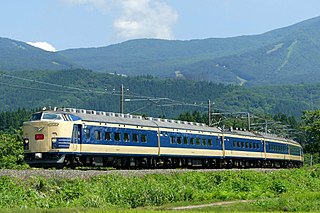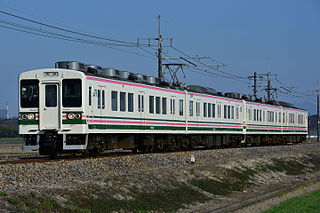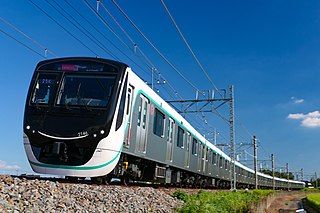
The Hachikō Line is a 92.0 km (57.2 mi) regional railway line owned and operated by East Japan Railway Company. It is located within Tokyo, Saitama, and Gunma Prefectures in Japan. It connects Hachiōji Station in Hachiōji, Tokyo with Kuragano Station in Takasaki, Gunma Prefecture.

The Kawagoe Line is a railway line in Japan operated by the East Japan Railway Company, which connects the cities of Saitama, Kawagoe, and Hidaka in Saitama Prefecture. The main transfer stations on the line are Ōmiya, Kawagoe, and Komagawa.

The E233 series (E233系) is a commuter and suburban electric multiple unit (EMU) train type developed by East Japan Railway Company from the earlier E231 series and the E531 series design. The first train was introduced in December 2006 for use on the Chūō Line (Rapid), followed by the E233-1000 series variant in 2007 for use on the Keihin–Tōhoku and Negishi lines, the E233-3000 series outer-suburban variant in December 2007 for use on the Tōkaidō Main Line, and narrow-bodied E233-2000 series variant for Jōban Line and Tokyo Metro Chiyoda Line through services. Further variants were built for use on the Keiyō Line, Yokohama Line, Saikyō Line, and Nambu Line.

The 201 series is a DC electric multiple unit (EMU) commuter train type introduced in 1979 by Japanese National Railways (JNR). It has been operated by West Japan Railway Company (JR-West) since 1987, and was formerly operated by East Japan Railway Company from 1987 until 20 June 2011.

The 205 series is a DC electric multiple unit (EMU) commuter train type introduced in 1985 by Japanese National Railways (JNR), and inherited by JR East and JR West after the privatization two years later. It is currently operated by East Japan Railway Company, West Japan Railway Company and KAI Commuter in Indonesia.

The 209 series (209系) is an electric multiple unit (EMU) commuter train type operated by East Japan Railway Company in the Tokyo area of Japan since 1993.

The Kabe Line is a railway line operated by West Japan Railway Company within the city of Hiroshima in Japan. It connects Hiroshima Station and Aki-Kameyama Station in Asakita-ku. The actual junction station is Yokogawa. It is one of the commuter lines to Hiroshima.

The 103 series is a DC electric multiple unit (EMU) commuter train type introduced in 1963 by Japanese National Railways (JNR), and currently operated by West Japan Railway Company and Kyushu Railway Company. They were also operated by East Japan Railway Company and Central Japan Railway Company.

The 101 series was a DC electric multiple unit (EMU) commuter train type introduced in 1957 by Japanese National Railways (JNR), and formerly operated by East Japan Railway Company and West Japan Railway Company (JR-West). The last remaining trains were withdrawn in November 2003.

The 113 series is a Japanese suburban electric multiple unit (EMU) train type introduced in 1963 by Japanese National Railways (JNR), currently operated by West Japan Railway Company (JR-West) and Shikoku Railway Company, and formerly also operated by East Japan Railway Company and Central Japan Railway Company.

The 581/583 series (581/583系) were limited express electric multiple unit (EMU) train types introduced in 1967 by Japanese National Railways and later operated by East Japan Railway Company and West Japan Railway Company on the through services express Kitaguni and other special trains until 2017.

The 107 series (107系) was a DC electric multiple unit (EMU) train type that was operated on local services by East Japan Railway Company in Japan from 1988 to 2017.

The 165 series was an express electric multiple unit (EMU) train type introduced in 1963 by Japanese National Railways (JNR).

The 413 series is a Japanese dual-voltage electric multiple unit (EMU) train type first introduced by Japanese National Railways (JNR) in March 1986, and later operated on local services on the Hokuriku Main Line by the West Japan Railway Company (JR-West) from 1987 and also by the third-sector railway operating company Ainokaze Toyama Railway from March 2015. The units were built by re-using the underframes, bogies and electrical equipment from former 471 series and 473 series express-type EMUs with new suburban type bodies based on the design of the 417 series EMUs introduced in 1978.

The E353 series (E353系) is a DC tilting electric multiple unit (EMU) train operated by the East Japan Railway Company in Japan on limited express services on the Chuo Main Line since December 2017.

The 227 series is a DC electric multiple unit (EMU) train operated by West Japan Railway Company (JR-West) for use on suburban services in the Hiroshima area of Japan since 14 March 2015, with plans for additional sets in the Kinki Region beginning in 2019.

The E235 series is a DC electric multiple unit (EMU) commuter and suburban train type operated by East Japan Railway Company. The commuter variant was introduced on Yamanote Line services in November 2015, and the suburban variant entered service on the Sōbu Rapid and Yokosuka Lines on 21 December 2020.

The 323 series is a DC electric multiple unit (EMU) train type operated by West Japan Railway Company on the Osaka Loop Line in Osaka, Japan, since December 2016. The trains replaced the ageing 103 series and 201 series trains.

The Tokyu 2020 series is an electric multiple unit (EMU) commuter train type built by J-TREC and used by the Japanese private railway operator Tokyu Corporation in the Tokyo area since March 2018. The 2020 series is used primarily on the Tokyu Den-en-toshi Line while its derivatives, the 3020 series and the 6020 series, are used mainly on the Tokyu Meguro Line and Tokyu Oimachi Line respectively.

The E131 series (E131系) is a DC electric multiple unit (EMU) train type operated by the East Japan Railway Company. It began operations in the Chiba area on 13 March 2021, on the Sagami Line on 18 November 2021, and on the Nikkō Line and the Utsunomiya Line on 12 March 2022. The trains are equipped for driver-only operation.



























